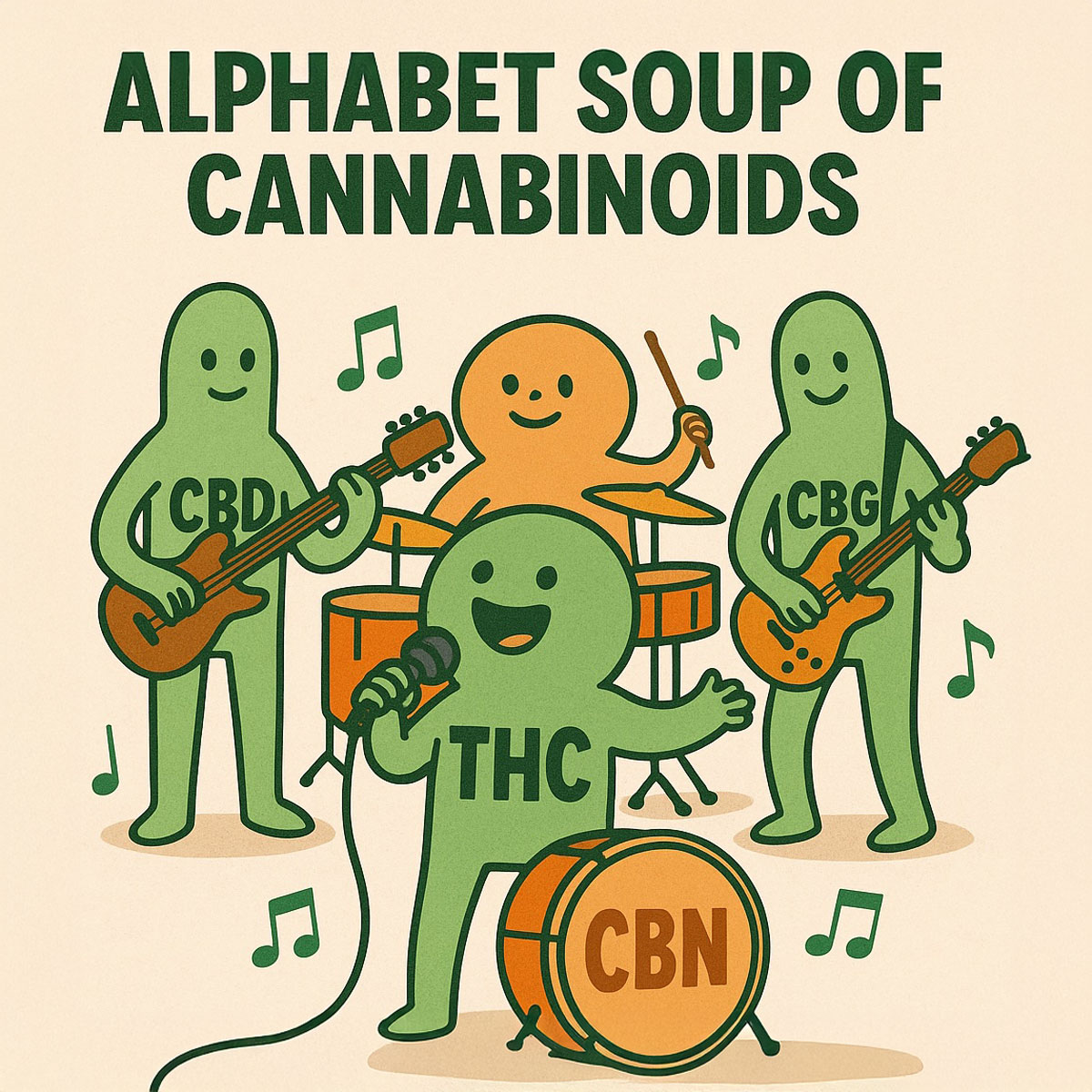Author: Dr. Kim, Medical Doctor at Aurea Care (Pen name)
Think of cannabis as a band. Most people only know the lead singer: THC—flashy, loud, unpredictable, hard to ignore. Maybe they’ve heard of CBD, the calm, steady bassist holding the groove.
But the rest of the crew? CBN, CBG, CBC, THCV? They sound more like tax codes than medicine. Yet they’re the session musicians no one talks about—and without them, the music falls flat.
Here’s the kicker: this band doesn’t just play stoner anthems. They’re molecular multi-instrumentalists, each tuning a different part of the body’s orchestra. And once you start listening for the harmonies, you start to see why some strains sedate, others uplift, and some do both at once.
That’s why one strain puts you to sleep, and another makes you reorganize your spice rack at 2 a.m. The mix matters.
Let’s meet the band.
THC: The Headliner
Delta-9-tetrahydrocannabinol. It’s the molecule most responsible for getting you high—but that’s just the opening act.
THC is a partial agonist at CB1 receptors, concentrated in the brain and spinal cord. That’s why it alters pain, mood, memory, and coordination.
It’s psychoactive, yes. But also analgesic, antispasmodic, anti-nausea, and appetite-boosting. For cancer patients, that means fewer vomits and more calories. For people with MS, looser limbs and quieter spasms. For chronic pain, it turns the volume down from eleven to four.
Too much, though? Cue anxiety, paranoia, and Swiss-cheese memory. THC is powerful. Use it like espresso: strategically, and know when to stop.
CBD: The Diplomat
Cannabidiol doesn’t bind well to CB1 or CB2 receptors. Instead, it works in more roundabout ways—modulating serotonin, calming glutamate storms, inhibiting enzymes like FAAH (which breaks down anandamide), and nudging oddball receptors like TRPV1 (pain and heat) and GPR55 (we’re still figuring that one out).
What does that mean in real life? Less anxiety. Better sleep. Lower inflammation. It won’t make you high, and it rarely sedates. But it smooths the edges. For some, it’s like noise-canceling for the nervous system.
Low doses tend to calm. High doses might do the opposite. Weird, yes. Welcome to cannabinoid pharmacology: where the dose-response curve doesn’t always read the manual.
CBN: The Afterparty
Cannabinol is what happens when THC ages—oxidized, mellowed, transformed. Think of it as THC’s sleepy cousin who shows up late, turns off the lights, and puts on pajamas.
CBN is mildly psychoactive, but it’s best known for its sedative vibe. It won’t knock you out—not on its own. But paired with THC? It’s like adding a weighted blanket to your endocannabinoid system.
Great for sleep. Useless for parties. Unless the party is in bed. With a book. At 9:30 p.m.
CBG: The Architect
Cannabigerol is the stem cell of cannabinoids —the molecule from which THC, CBD, and others are synthesized in the plant. It’s the blueprint, the master key.
Pharmacologically, CBG has antibacterial, anti-inflammatory, and neuroprotective properties. It binds to both CB1 and CB2, but also works on other systems—adrenergic, serotonergic, maybe more.
Early research hints at potential in glaucoma, inflammatory bowel disease, and even neurodegenerative conditions.
CBG doesn’t make headlines. It builds them.
THCV, CBC, and the Rest of the Choir
- THCV: Like THC’s quirky cousin. In small doses, it can suppress appetite (hello, weight loss studies). In larger ones, it may act more like THC, but with a shorter high.
- CBC: Anti-inflammatory and antidepressant properties, probably via non-cannabinoid receptors. Early-stage research, but promising.
- Delta-8-THC: A smoother, less potent version of Delta-9. Popular in U.S. markets skirting legality. Mild euphoria, less anxiety.
And there are dozens more—each with its own fingerprint. Most remain understudied, underfunded, and underappreciated. The cannabis plant contains over a hundred cannabinoids, most of which we know next to nothing about.
Why It Matters
We used to think cannabis was a blunt tool. One plant. One effect. One-size-fits-all.
But the truth is, cannabis is a molecular toolkit—full of switches, dials, and modulators. And depending on the ratio, dose, and delivery, you can get wildly different results.
Pain relief without sedation. Sleep without grogginess. Anxiety reduction without emotional blunting. But you don’t get there by accident. You get there by understanding the chemistry. Listening to the body. And sometimes, trial and error.
Final Thought: The Symphony, Not the Solo
Modern medicine likes single compounds. One target. One mechanism. One effect. But the endocannabinoid system is more like jazz than classical. It improvises. It adapts. It needs the full band.
So next time someone asks if you’re pro-THC or pro-CBD, remind them: that’s like choosing between the melody and the rhythm section. The real magic is in the interplay.
Welcome to the cannabinoid symphony.
We’re only beginning to hear the music.

